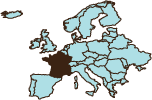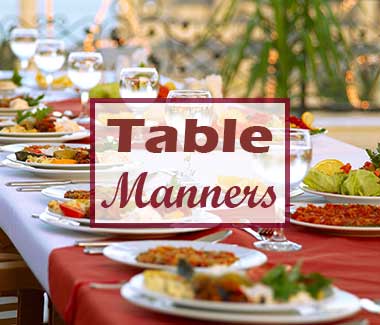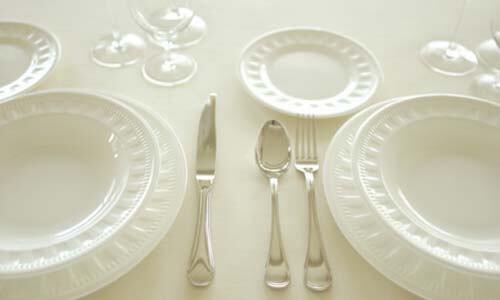French Dining Etiquette
international dining etiquette
Dining etiquette for toasts. Toasting etiquette dictates that guests wait for the host to initiate the first toast, but should then offer a toast in return at some point during the meal as a form of gratitude to the host(s).
The most common toasts are salud or a votre sante (to your health).
table manners
Dining etiquette for beginning to eat. Do not begin eating until the host says, “Bon appetit!”
Dining etiquette for utensils. The knife remains in the right hand, and the fork remains in the left. When the meal is finished, the knife and fork are laid parallel to each other across the right side of the plate.
Dining etiquette for the place setting. The knife above your plate is for bread and butter (or it may be a smallish knife laid by the side of the main plate; a bread plate is rare, and bread is usually broken by hand, with a small piece being laid on the left side of the main plate directly on the table). The fork and spoon above your plate are for dessert. Always start from the outside and work your way in, course by course. There will be separate glasses provided at your setting for water, white and red wine, and champagne (after-dinner drink glasses come out after dinner).
Dining etiquette for your hands. When not holding utensils, your hands should be visible above the table.
Dining etiquette for passing food. Pass all dishes to your left.
Dining etiquette for eating salad. Never cut your lettuce: fold it with your knife and fork into a little bundle that can be picked up with your fork.
Dining etiquette for seating. The most honored position is at the head of the table, with the most important guests seated first to the left and then to the right of the head of the table. If there is a hosting couple, one will be seated at each end of the table.
Dining etiquette for refills and seconds. You are expected to eat all food on your plate and you should not ask for seconds. You may always have additional beverages; drink enough to cause your cup or glass to be less than half full, and it will generally be refilled.
Dining etiquette for restaurants. There are many varieties of restaurants, beginning with the formal and elegant establishments serving haute cuisine right on down to the creperie food stand on the street. There are several types in between: the bistros-or, originally, the bar-now usually a family-run establishment offering good, substantial fare that accompanies drinks; the brasserie, offering snacks (not to be confused with fast food) and traditional meals; and less formal restaurants, where reservations may not be necessary. In informal restaurants, you may be required to share a table: if so, do not force conversation: act as if you are seated at a private table.
Dining etiquette for discussing business. The business lunch or dinner are widespread. Take your cue from your French associates: if they bring up business at a meal, then it's okay to discuss it.
Dining etiquette for the home. When invited to a colleague's home for a formal meal, remember that the meal itself, and the formality surrounding it, is theater, and that you are an actor in this great French play. Play your part well. Once within the home, you will be told where to sit, and there you should remain. Do not wander from room to room: much of the house is really off-limits to guests. Use the toilet before you arrive, as it is considered bad form to have to leave the dinner party, or the table, at any time. Once you (and the group) are invited to another room, most probably the dining room, be sure to allow the more senior members of your party to enter the room ahead of you: men should also move aside to allow women to enter ahead of them.
At the table, be sure to look for place cards, or wait until the host indicates your seat: do not presume to seat yourself, as the seating arrangement is usually predetermined. The meal-after aperitifs and a few appetizers (do not expect much in the way of pre-meal appetizers: the meal is the important focus) follows several courses:
fish (with white wine or champagne)
meat (with red wine)
salad (generally, because of the vinegar dressing, wine is not served with salad; the drink is usually mineral water): may not be part of every meal, but if it is served, it comes after the meat course, not alongside or before it
cheese (usually with a different red wine): usually comprised of several varieties with different shapes, textures, and robustness. Take small portions, along with some bread. When serving yourself, round-shaped cheeses should be cut beginning from the center, in sequential, triangular wedges (never cut round-shaped cheeses from the side): rectangular, conical, or square-shaped cheeses should be sliced in small portions beginning from the cut end. Bread is served throughout the meal, and is the only food, except for sandwiches and asparagus spears, that can properly be eaten at the table with the hand; almost everything in France is eaten with a knife, fork, or spoon. (Asparagus spears are often served on a separate vegetable plate and should be lifted by hand and dipped in the sauce-usually butter-that accompanies it.)
dessert (with a sweetish dessert wine, usually white): usually not served with coffee
coffee (usually served after dessert, and often served with an after-dinner drink)
chocolates (usually served with postprandials)
Dining etiquette for paying the bill. Usually the one who does the inviting pays the bill. Sometimes other circumstances determine the payee (such as rank).
Dining etiquette for tipping. At restaurants, 10 to 15 percent will be included in your bill.




